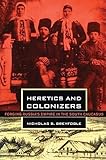Heretics and Colonizers : Forging Russia's Empire in the South Caucasus / Nicholas B. Breyfogle.
Material type: TextPublisher: Ithaca, NY : Cornell University Press, [2011]Copyright date: ©2011Description: 1 online resource (376 p.) : 5 maps, 18 halftonesContent type:
TextPublisher: Ithaca, NY : Cornell University Press, [2011]Copyright date: ©2011Description: 1 online resource (376 p.) : 5 maps, 18 halftonesContent type: - 9780801463563
- 947.507 22
- online - DeGruyter
| Item type | Current library | Call number | URL | Status | Notes | Barcode | |
|---|---|---|---|---|---|---|---|
 eBook
eBook
|
Biblioteca "Angelicum" Pont. Univ. S.Tommaso d'Aquino Nuvola online | online - DeGruyter (Browse shelf(Opens below)) | Online access | Not for loan (Accesso limitato) | Accesso per gli utenti autorizzati / Access for authorized users | (dgr)9780801463563 |
Frontmatter -- CONTENTS -- Acknowledgments -- Note on Translation and Transliteration -- Abbreviations -- Maps -- INTRODUCTION -- PART I. THE ROAD TO TRANSCAUCASIA -- 1. TOLERATION THROUGH ISOLATION. The Edict of 1830 and the Origins of Russian Colonization in Transcaucasia -- 2. TO A LAND OF PROMISE. Sectarians and the Resettlement Experience -- PART II. LIFE ON THE SOUTH CAUCASIAN FRONTIER -- 3. “IN THE BOSOM OF AN ALIEN CLIMATE”. Ecology, Economy, and Colonization -- 4. HERETICS INTO COLONIZERS. Changing Roles and Transforming Identities on the Imperial Periphery -- 5. FRONTIER ENCOUNTERS. Conflict and Coexistence between Colonists and South Caucasians -- PART III. THE DUKHOBOR MOVEMENT -- 6. FROM COLONIAL SETTLERS TO PACIFIST INSURGENTS. The Origins of the Dukhobor Movement, 1887–1895 -- 7. PEASANT PACIFISM AND IMPERIAL INSECURITIES. The Burning of Weapons, 1895–1899 -- THE END OF AN ERA AND ITS MEANINGS -- Selected Bibliography -- Index
restricted access online access with authorization star
http://purl.org/coar/access_right/c_16ec
In Heretics and Colonizers, Nicholas B. Breyfogle explores the dynamic intersection of Russian borderland colonization and popular religious culture. He reconstructs the story of the religious sectarians (Dukhobors, Molokans, and Subbotniks) who settled, either voluntarily or by force, in the newly conquered lands of Transcaucasia in the nineteenth century. By ordering this migration in 1830, Nicholas I attempted at once to cleanse Russian Orthodoxy of heresies and to populate the newly annexed lands with ethnic Slavs who would shoulder the burden of imperial construction.Breyfogle focuses throughout on the lives of the peasant settlers, their interactions with the peoples and environment of the South Caucasus, and their evolving relations with Russian state power. He draws on a wide variety of archival sources, including a large collection of previously unexamined letters, memoirs, and other documents produced by the sectarians that allow him unprecedented insight into the experiences of colonization and religious life. Although the settlers suffered greatly in their early years in hostile surroundings, they in time proved to be not only model Russian colonists but also among the most prosperous of the Empire's peasants. Banished to the empire's periphery, the sectarians ironically came to play indispensable roles in the tsarist imperial agenda.The book culminates with the dramatic events of the Dukhobor pacifist rebellion, a movement that shocked the tsarist government and received international attention. In the early twentieth century, as the Russian state sought to replace the sectarians with Orthodox settlers, thousands of Molokans and Dukhobors immigrated to North America, where their descendants remain to this day.
Mode of access: Internet via World Wide Web.
In English.
Description based on online resource; title from PDF title page (publisher's Web site, viewed 26. Apr 2024)


